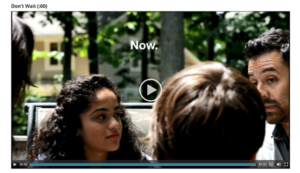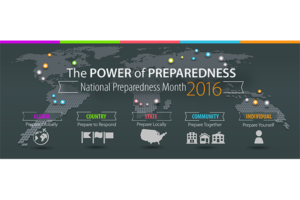Emergency Preparedness: Social and Behavior Change Can’t Wait
Say an emergency were to hit your community at this very moment. Would it be ready?
 September 30 is America’s PrepareAthon and marks the end of National Preparedness Month. This annual reminder is coordinated by the Ready Campaign, a public service advertising campaign launched by The Department of Homeland Security (DHS) and The Federal Emergency Management Agency (FEMA) and links nationwide preparedness efforts.
September 30 is America’s PrepareAthon and marks the end of National Preparedness Month. This annual reminder is coordinated by the Ready Campaign, a public service advertising campaign launched by The Department of Homeland Security (DHS) and The Federal Emergency Management Agency (FEMA) and links nationwide preparedness efforts.
This year’s theme, “Don’t Wait, Communicate. Make Your Emergency Plan Today,” is accompanied by a social media toolkit with instructional videos, public service announcements, graphics, related links and an app promoting steps toward individual, family and community preparedness.
But let’s zoom out a little and look at how prepared the world is to handle public health emergencies.
One-third prepared
 The International Health Regulations (IHR), a legal framework for preventing international spread of disease, sets procedures and core capacities that every country is required to meet. They are largely operational, including surveillance, reporting and technical capabilities such as laboratory analysis and logistics. Though there is an item requiring the capacity to create multidisciplinary teams for emergency response.
The International Health Regulations (IHR), a legal framework for preventing international spread of disease, sets procedures and core capacities that every country is required to meet. They are largely operational, including surveillance, reporting and technical capabilities such as laboratory analysis and logistics. Though there is an item requiring the capacity to create multidisciplinary teams for emergency response.
The most recent edition of the IHR went into effect in 2007 with a deadline for 2012. As of 2014, however, just over 30 percent of countries have implemented the procedures and core capacities. This means nearly 70 percent of the countries are likely to be overwhelmed and would need international assistance in the event of a large-scale public health emergency.
Like emergency preparedness, an international emergency response typically deploys a fleet of technical experts. Teams like USAID’s Disaster Assistance Response Team (DART) are among the first on scene to identify and prioritize rescue and relief needs. First responders also include medical workers and volunteers, as well as nutrition, water, sanitation and disease surveillance experts for health emergencies. Humanitarian assistance and relief organizations assist with emergency supplies and rehabilitation. Many of them also support long-term recovery efforts and development programs battling hunger and poverty. All told, a response involves many actors and roles.
Experts missing in action
There is, however, a weak link in the emergency response: a short-sighted role for communication. Emergency communication guidelines generally resemble risk communication tactics, which include being empathetic, translating the complex science into easy to understand risks and providing actionable information to allow good decision-making. These objectives may be satisfactory when trying to manage public emotions, yet they can sometimes position the public as adversaries instead of partners. And there’s a faulty underlying assumption: that every audience is the same. The truth is, a local culture can be as complex as a novel disease.
As we’ve seen in the 2014-2016 Ebola Virus Disease outbreak in West Africa, behaviors that drive a crisis can be changed to behaviors that end the crisis. But behavior change is not the result of situation reports and health advisories; it requires listening to the audience. To do this, crisis communicators will need to work with a distinct set of experts.
Detecting audience attitudes and understanding how they shape behavior is a social and behavioral science. In the Ebola outbreak, anthropologists were central in translating the complex local culture, implementing community-led approaches and proposing culturally acceptable behavior alternatives. Social and behavior change communication (SBCC) experts from the Health Communication Capacity Collaborative (HC3) also made an impact by systematically gathering audience insight, applying behavioral theory, engaging communities with Bridges of Hope (an Ebola education toolkit) and monitoring and debunking rumors. HC3 also developed an online portal of curated Ebola communication resources and an Ebola Preparedness implementation kit for communication and public health workers. The result? People were not just informed and equipped, they were also motivated to support the emergency response.
In countries now facing Zika, SBCC experts are using the same principles to save more lives. HC3 conducted a rapid landscape exercise to evaluate Zika communication in four Latin American countries. This snapshot of the current Zika situation and response became the foundation for the Zika Prevention Strategic Communication Framework, a resource HC3 is developing for immediate use. With the framework, public health workers will be able to design Zika prevention behavior change and communication strategies that are evidence-driven.
Social and behavior change, don’t wait until it’s too late
HC3’s work in countries affected by Ebola and Zika has shown that SBCC expertise also makes an impact before a public health emergency strikes and long after the crisis passes:
- Finding and building on trusted information channels
- Monitoring audience beliefs about the emerging health concerns
- Restoring confidence during recovery from an emergency
- Engaging communities in rebuilding and improving health services and
- Setting a communication foundation to prepare for the next emergency.
A great deal of emergency preparedness is learned by trial and error. Whether rehearsing emergency drills or facing a real life-threatening event, each lesson shared provides an opportunity for incremental improvement. Ebola taught us that experts who study culture are just as needed as experts who study disease. So why wait to recruit them until responders encounter community resistance? Including them in preparedness exercises and capacity requirements means the response will be led by communities and supported by experts, instead of the other way around.
As a part of its mission to strengthen communication capacity of SBCC experts around the world, HC3 is sharing tools, resources and lessons learned as its work in public health emergencies unfold.









Leave a Reply
Want to join the discussion?Feel free to contribute!